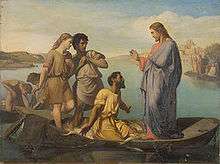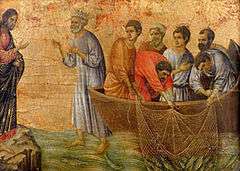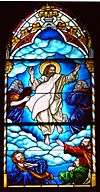Miraculous catch of fish
The miraculous catch of fish or more traditionally the Miraculous Draught of Fish/es, is either of two miracles attributed to Jesus in the Canonical gospels. The miracles are reported as taking place years apart from each other, but in both miracles apostles are fishing unsuccessfully in the Sea of Galilee when Jesus tells them to try one more cast of the net, at which they are rewarded with a great catch (or "draught", as in "haul" or "weight"). Either is thus sometimes called a "miraculous draught of fish".
Overview
In the Gospel of Luke (Luke 5:1–11),[1] the first miraculous catch of fish takes place early in the ministry of Jesus and results in Peter as well as James and John, the sons of Zebedee, joining Jesus vocationally as disciples.[2][3][4]
The second miraculous catch of fish is also called the "miraculous catch of 153 fish," and seems to recall the first catch. It is reported in the last chapter of the Gospel of John (John 21:1–14)[5] and takes place after the Resurrection of Jesus.[6][7][8][9]
In Christian art, the two miracles are distinguished by the fact that in the first miracle Jesus is shown sitting in the boat with Peter, while in the second miracle he is standing on the shore.
First miraculous catch of fish
According to the Gospel of Luke,[1] on the day of this miracle, Jesus was preaching near the Lake of Genesareth (Sea of Galilee), when he saw two boats at the water's edge. Boarding the one belonging to Simon (Peter), and moving out a little from shore, he sat and taught the people from the boat. Afterwards, he said to Peter:
- "Put out into deep water, and let down the nets for a catch."[1]
Peter answered:
- "Master, we've worked hard all night and haven't caught anything. But because you say so, I will let down the nets."[1]
When they had done so, "they caught such a large number of fish that their nets began to break,"[1] requiring help from another boat. When Peter saw the large catch, which filled both boats almost to sinking point, he fell at Jesus' knees and said, "Go away from me, Lord; I am a sinful man!"[1] Jesus responded "Don't be afraid; from now on you will catch men,"[1] after which Peter and his partners James and John left everything and followed Jesus.
Second miraculous catch of fish—153 large ones

According to John 21:11
- "Simon Peter climbed back into the boat and dragged the net ashore. It was full of 153 large fish, but even with so many the net was not torn".
This has become known popularly as the "153 fish" miracle. Gospel of John,[5] seven of the disciples—Peter, Thomas, Nathanael, the sons of Zebedee (James and John), and two others – decided to go fishing one evening after the Resurrection of Jesus, but caught nothing that night. Early the next morning, Jesus (whom they had not recognised) called out to them from the shore:
- "Friends, haven't you any fish?"[5]
When they reply in the negative (the question in Greek uses a particle which expects the answer "No"),[10][11] Jesus responds: "Throw your net on the right side of the boat and you will find some".[5] After doing so, "they were unable to haul the net in because of the large number of fish".[5]
Realising the identity of their advisor, the disciple whom Jesus loved said to Peter, "It is the Lord!"[5] at which Peter jumped into the water to meet him (an aspect of the story often illustrated in Christian art), while the remaining disciples followed in the boat, towing the net, which proved to be full of 153 large fish.[5]
This passage has traditionally been one of the liturgical readings following Easter, and sermons have been preached on it by Augustine of Hippo[12] and John Chrysostom,[13] among others.
153 fish
The precision of the number of fish as 153 has long been considered, and various writers have argued that the number 153 has some deeper significance, with many conflicting theories having been offered (see the discussion on the number 153 in the Bible). Discussing some of these theories, theologian D. A. Carson suggests that "If the Evangelist has some symbolism in mind connected with the number 153, he has hidden it well,"[14] while other scholars note "No symbolic significance for the number of 153 fish in John 21:11 has received widespread support".[15]
References to aspects of the miracle, or to the general idea of being "fishers of men," can sometimes be recognised by uses of the number 153. For example, St Paul's School in London was founded in 1512 by John Colet to teach 153 poor men's children: although the school is now considerably larger, it still has 153 Foundation Scholars, who since the 19th century have worn a fish emblem on their watch-chains, or, more recently, in their button-holes.[16][17]
In Iamblichus' Life of Pythagoras, a tale is mentioned in which Pythagoras, while journeying from Sybaris to Crotona, is said to have met some fishermen, who were drawing their net heavily laden to the shore, and he told them the exact number of fish they caught. In this reference, the exact number is not mentioned.[18]
Gallery of art
| Wikimedia Commons has media related to Miraculous draught of fish. |
- Depictions of The Miraculous catch of fish
- Stained glass detail, Canterbury Cathedral (first miracle)
 Painting by Anton Losenko, 1762 (first miracle)
Painting by Anton Losenko, 1762 (first miracle) The Miraculous Draft of Fishes by Konrad Witz, 1444 (second miracle)
The Miraculous Draft of Fishes by Konrad Witz, 1444 (second miracle) Painting by Jacopo Bassano, 1545 (first miracle )
Painting by Jacopo Bassano, 1545 (first miracle )_-_James_Tissot_-_overall.jpg) Water color by James Tissot (first miracle )
Water color by James Tissot (first miracle ) painting by H. Picou, 1850s (1s miracle)
painting by H. Picou, 1850s (1s miracle)
See also
- Chronology of Jesus
- Life of Jesus in the New Testament
- Ministry of Jesus
- Miracles of Jesus
- Parables of Jesus
- Restoration of Peter
References
- 1 2 3 4 5 6 7 "Luke 5:1–11, New International Version". Biblegateway. Retrieved 2012-07-18.
- ↑ John Clowes, The Miracles of Jesus Christ published by J. Gleave, Manchester, UK, 1817, page 214, available on Google books
- ↑ The Gospel of Luke by Timothy Johnson, Daniel J. Harrington, 1992 ISBN 0-8146-5805-9 page 89
- ↑ The Gospel of Luke, by Joel B. Green 1997 ISBN 0-8028-2315-7 page 230
- 1 2 3 4 5 6 7 "John 21:1–14, New International Version". Biblegateway. Retrieved 2012-07-18.
- ↑ Lockyer, Herbert, 1988 All the Miracles of the Bible ISBN 0-310-28101-6 page 248
- ↑ The Gospel of John by Francis J. Moloney, Daniel J. Harrington, 1998 ISBN 0-8146-5806-7 page 549
- ↑ The Gospel of John by Frederick Fyvie Bruce, 1994 ISBN 0-8028-0883-2 page 400
- ↑ Reading the Gospel of John by Kevin Quast 1991 ISBN 0-8091-3297-4 page 142
- ↑ J.W. Wenham, The Elements of New Testament Greek, Cambridge University Press, 1965, p. 75.
- ↑ Boyce W. Blackwelder, Light from the Greek New Testament, Baker Book House, 1976, p. 120, ISBN 0-8010-0662-7.
- ↑ John E. Rotelle (ed) and Edmund Hill (tr), The works of Saint Augustine: A Translation for the 21st Century, Part 3, Volume 7 (Sermons: On the Liturgical Seasons), ISBN 1-56548-059-7.
- ↑ Chrysostom, Homily 87 on the Gospel of John.
- ↑ D. A. Carson, The Gospel According to John (Pillar Commentaries Series), Wm. B. Eerdmans Publishing, 1991, p. 673, ISBN 0-85111-749-X.
- ↑ Leland Ryken, Jim Wilhoit, Tremper Longman, Colin Duriez, Douglas Penney, and Daniel G. Reid, Dictionary of Biblical Imagery (Fish), InterVarsity Press, 1998, p. 290, ISBN 0-8308-1451-5.
- ↑ Peter Cunningham, Modern London; or, London as it is, 1851, p. 193.
- ↑ Mead, A.H. (1990). A Miraculous Draught of Fishes: a history of St Paul's School. London: James & James. p. 15. ISBN 0-907383-05-X.
- ↑ Iamblichus. (trans. Thomas Taylor), Life of Pythagoras, or, Pythagoric life, J.M Watkins, 1818, p. 17.
.jpg)

